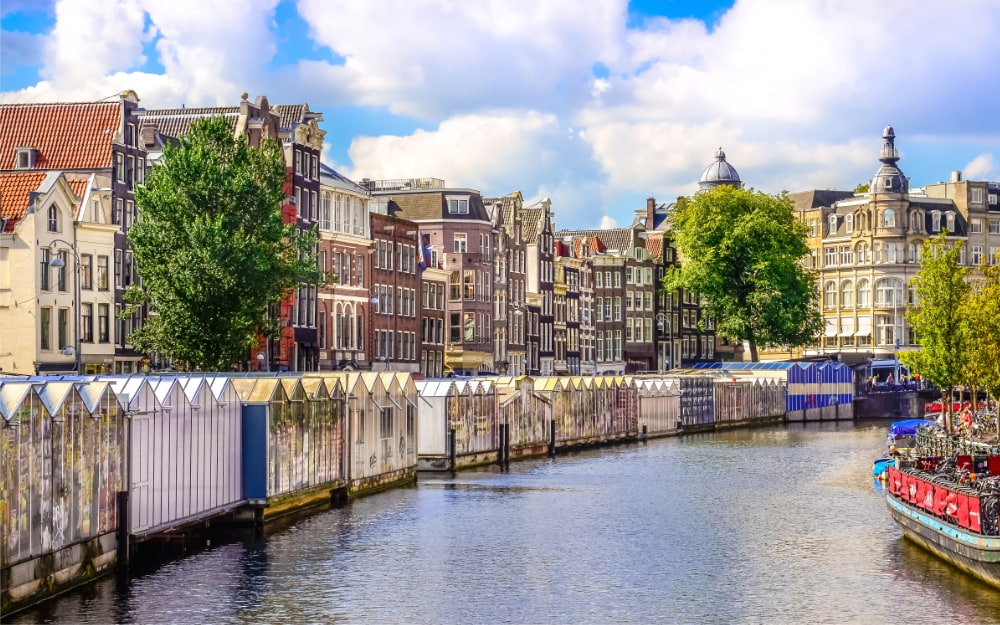Population in Urban Area, now
- World: 506th
- Europe: 45th
- Netherlands: 1st
Population in City Area, 2022-03-09
- World: 503rd
- Europe: 52nd
- Netherlands: 1st
Amsterdam Urban Area Population Graph
Amsterdam Population Review
The nominal capital of the Netherlands, Amsterdam is the country’s largest and most visited city. The city of Amsterdam is home to 740 thousand people, with 1.1 million living in the urban area. Amsterdam is located in the North Holland province and originally started its existence as a small fishing village in the 13th century.
The picturesque city is known for its canals (of which it has 165), its architecture, its live-and-let-live attitude, rich history, and it’s laidback attitude towards cannabis. It is also an extremely popular tourist destination that continues to attract people from around the world.
A city of bicycles
Amsterdam is an incredibly bicycle-friendly city and is seen as one of the most important centers of bicycle culture in the world. Their convenience, the city’s small size, and its 400 kilometers of bike paths make it an ideal location for bicycling. There are over 1 million bicycles in the city and it’s typical for both tourists and locals to get around the city on bicycle. There are over 490,000 cyclists that bike 2 million kilometers every day. However, Amsterdam is not a bicycling paradise for all. 44% of people who bike regularly in the city feel unsafe doing so, and the city has a relatively high number of cyclist fatalities every year.
The red light district
Amsterdam is famous for its frank way of dealing with sex work and its red light district has become world famous for it. The city’s tolerant view towards sex work has attracted many sex works and tourists to the city. There are 330 brothel windows in the red light district and 25,000 sex workers, 5% of which are men. But the future of the red light district has become uncertain. Raucous tourists flooding the red light district to stare or photograph the workers (without permission) have pushed out many of the locals and made the sex workers unsafe and uncomfortable. Amsterdam has banned guided tours of the red-light district in an attempt to limit tourists from going there.
A tourism hotspot
Tourists visit Amsterdam to see the Van Gogh Museum, Anne Frank’s house, the Rijksmuseum, and the marijuana cafes that dot the city. They also come for the red light district. The city’s tourism numbers have continued to go up. In 2018 alone, Amsterdam welcomed 19 million tourists. This was an increase of about three million visitors over the previous year. Before COVID-19 affected tourism levels, Amsterdam was predicting up to 21 million visitors would come to the city—for a city of 741,000, that’s quite the influx. Much of the people who visit Amsterdam for holiday or business purposes come from Germany. There are around 5 million German tourists visiting the neighboring country each year. Combined with the British and Belgians, these three countries account for almost half of the tourists coming to the country.
As tourism numbers grow, the use of the Amsterdam Airport Schiphol also continues to grow. In 2019, there were approximately 20 million passengers that moved through the airport—an increase over the previous years when the airport only saw 18.8 million passengers.
A waning industrial section
Industrial activities around Amsterdam have diminished over the years. While the city still has involvement in shipbuilding, food processing, and diamond polishing, the city continues to struggle with unemployment. Amsterdam’s economic policy looks to attract industrial investment by providing training, temporary workers, and grants to employers. The government also created thousands of government subsidized jobs to further bolster the city’s employment rate.
